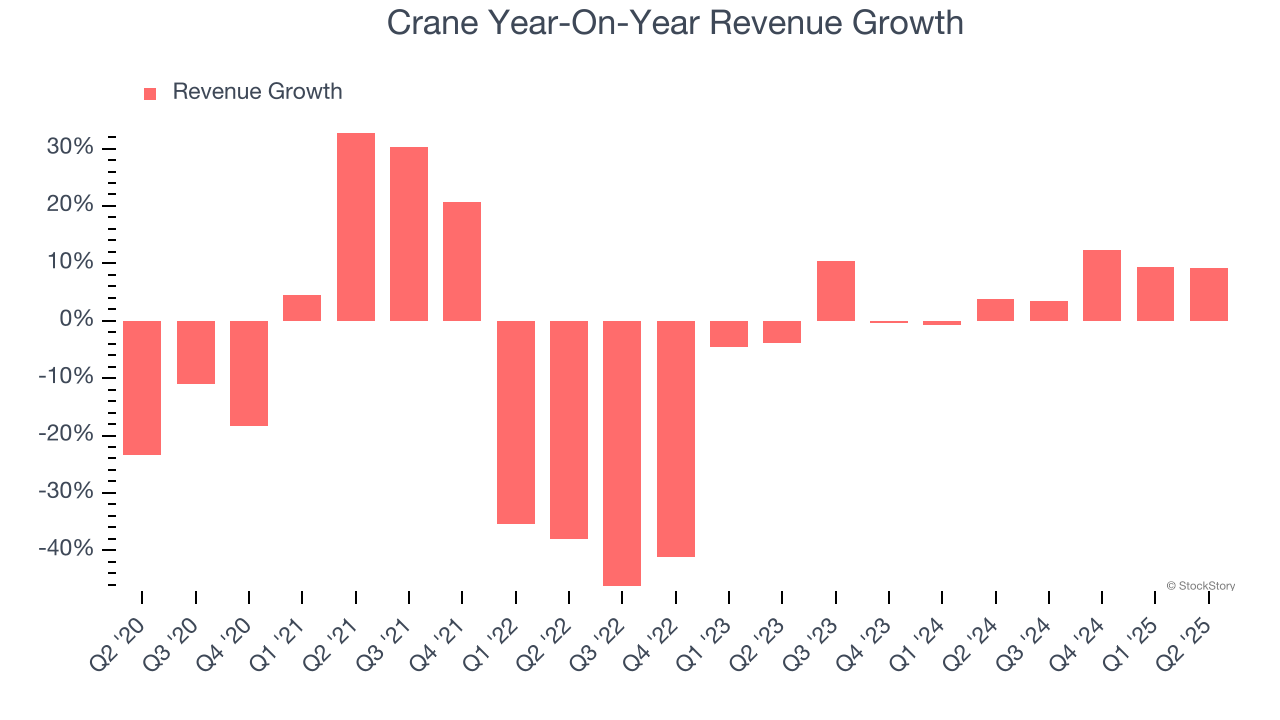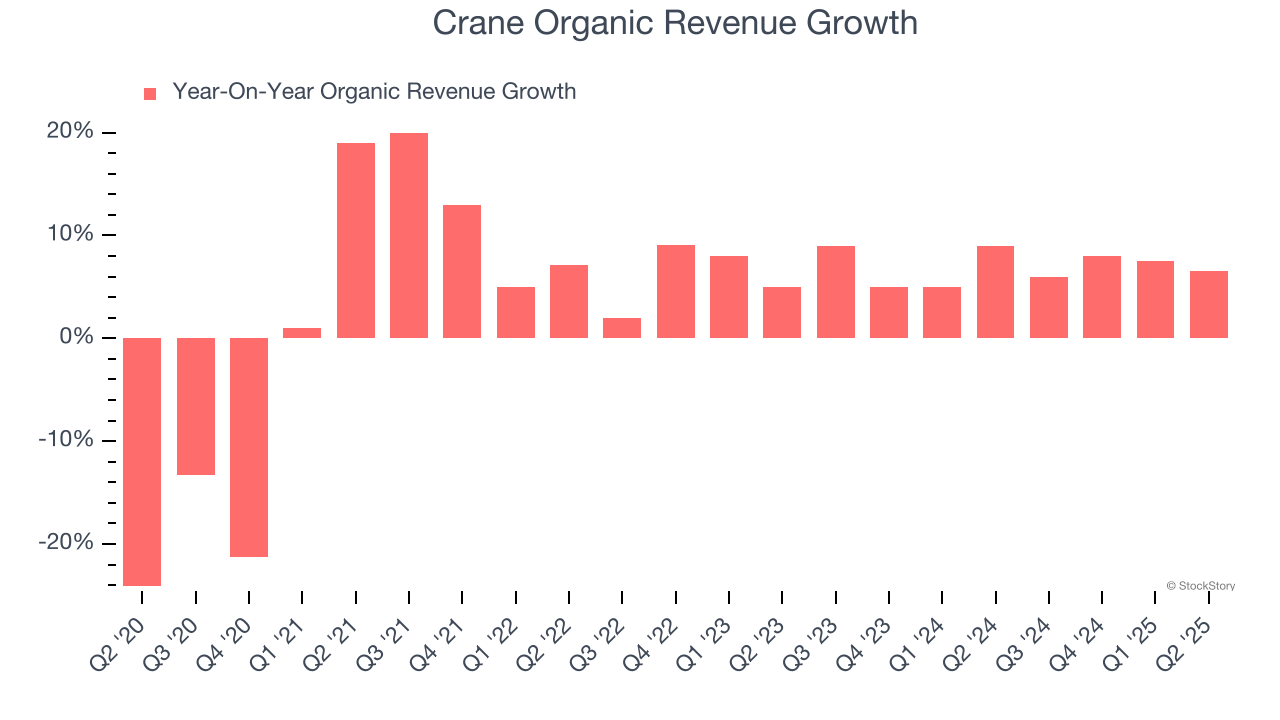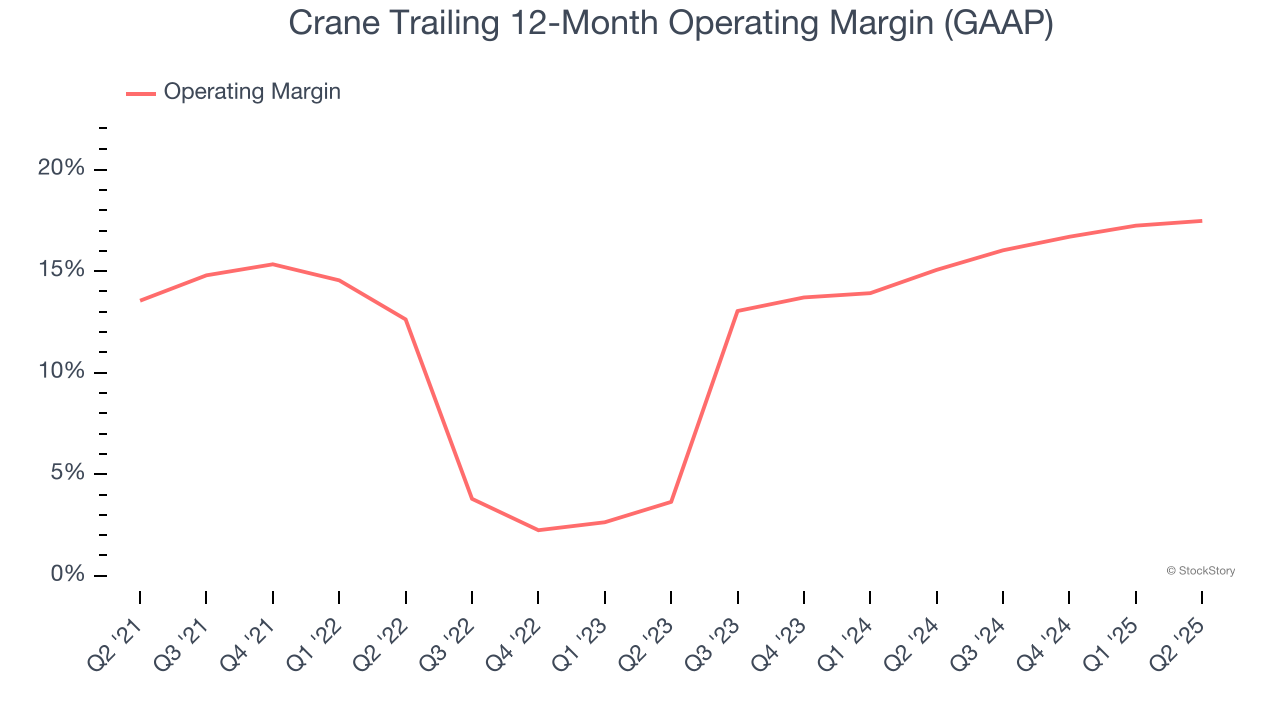
Industrial conglomerate Crane (NYSE:CR) reported Q2 CY2025 results topping the market’s revenue expectations, with sales up 9.2% year on year to $577.2 million. Its non-GAAP profit of $1.49 per share was 11.7% above analysts’ consensus estimates.
Is now the time to buy Crane? Find out by accessing our full research report, it’s free.
Crane (CR) Q2 CY2025 Highlights:
- Revenue: $577.2 million vs analyst estimates of $570.4 million (9.2% year-on-year growth, 1.2% beat)
- Adjusted EPS: $1.49 vs analyst estimates of $1.33 (11.7% beat)
- Adjusted EBITDA: $121.9 million vs analyst estimates of $118 million (21.1% margin, 3.3% beat)
- Management raised its full-year Adjusted EPS guidance to $5.65 at the midpoint, a 3.7% increase
- Operating Margin: 17.8%, in line with the same quarter last year
- Free Cash Flow Margin: 15.4%, up from 10.3% in the same quarter last year
- Organic Revenue rose 6.5% year on year (9% in the same quarter last year)
- Market Capitalization: $10.97 billion
Max Mitchell, Crane's Chairman, President and Chief Executive Officer, stated: "My thanks and appreciation to the global Crane team for delivering another excellent quarter, with 24% adjusted EPS growth on 6.5% core sales growth resulting from our focus on exceeding our customers’ expectations with exceptional technology and service. Demand trends across our strategic growth platforms remained strong in the quarter, with 19.6% year-over-year core order growth and 18.2% year-over-year core backlog growth."
Company Overview
Based in Connecticut, Crane (NYSE:CR) is a diversified manufacturer of engineered industrial products, including fluid handling, and aerospace technologies.
Revenue Growth
A company’s long-term performance is an indicator of its overall quality. Any business can experience short-term success, but top-performing ones enjoy sustained growth for years. Crane’s demand was weak over the last five years as its sales fell at a 6.1% annual rate. This wasn’t a great result and is a sign of poor business quality.

Long-term growth is the most important, but within industrials, a half-decade historical view may miss new industry trends or demand cycles. Crane’s annualized revenue growth of 5.8% over the last two years is above its five-year trend, but we were still disappointed by the results. 
We can better understand the company’s sales dynamics by analyzing its organic revenue, which strips out one-time events like acquisitions and currency fluctuations that don’t accurately reflect its fundamentals. Over the last two years, Crane’s organic revenue averaged 7% year-on-year growth. Because this number aligns with its normal revenue growth, we can see the company’s core operations (not acquisitions and divestitures) drove most of its results. 
This quarter, Crane reported year-on-year revenue growth of 9.2%, and its $577.2 million of revenue exceeded Wall Street’s estimates by 1.2%.
Looking ahead, sell-side analysts expect revenue to grow 6.8% over the next 12 months, similar to its two-year rate. Although this projection suggests its newer products and services will spur better top-line performance, it is still below the sector average.
Today’s young investors won’t have read the timeless lessons in Gorilla Game: Picking Winners In High Technology because it was written more than 20 years ago when Microsoft and Apple were first establishing their supremacy. But if we apply the same principles, then enterprise software stocks leveraging their own generative AI capabilities may well be the Gorillas of the future. So, in that spirit, we are excited to present our Special Free Report on a profitable, fast-growing enterprise software stock that is already riding the automation wave and looking to catch the generative AI next.
Operating Margin
Crane has been an efficient company over the last five years. It was one of the more profitable businesses in the industrials sector, boasting an average operating margin of 12.7%. This result isn’t surprising as its high gross margin gives it a favorable starting point.
Looking at the trend in its profitability, Crane’s operating margin rose by 3.9 percentage points over the last five years, showing its efficiency has improved.

In Q2, Crane generated an operating margin profit margin of 17.8%, in line with the same quarter last year. This indicates the company’s cost structure has recently been stable.
Earnings Per Share
Revenue trends explain a company’s historical growth, but the long-term change in earnings per share (EPS) points to the profitability of that growth – for example, a company could inflate its sales through excessive spending on advertising and promotions.
Crane’s EPS grew at a weak 3% compounded annual growth rate over the last five years. On the bright side, this performance was better than its 6.1% annualized revenue declines and tells us management adapted its cost structure in response to a challenging demand environment.

Diving into the nuances of Crane’s earnings can give us a better understanding of its performance. As we mentioned earlier, Crane’s operating margin was flat this quarter but expanded by 3.9 percentage points over the last five years. This was the most relevant factor (aside from the revenue impact) behind its higher earnings; interest expenses and taxes can also affect EPS but don’t tell us as much about a company’s fundamentals.
Like with revenue, we analyze EPS over a more recent period because it can provide insight into an emerging theme or development for the business.
For Crane, its two-year annual EPS declines of 6.7% show it’s continued to underperform. These results were bad no matter how you slice the data.
In Q2, Crane reported EPS at $1.49, up from $1.30 in the same quarter last year. This print easily cleared analysts’ estimates, and shareholders should be content with the results. Over the next 12 months, Wall Street expects Crane’s full-year EPS of $5.52 to grow 6.5%.
Key Takeaways from Crane’s Q2 Results
It was great to see Crane’ raise its full-year EPS guidance. We were also happy its revenue, EPS, and EBITDA outperformed Wall Street’s estimates. Overall, we think this was a solid quarter with some key areas of upside. The stock traded up 4.5% to $198.50 immediately following the results.
Crane may have had a good quarter, but does that mean you should invest right now? The latest quarter does matter, but not nearly as much as longer-term fundamentals and valuation, when deciding if the stock is a buy. We cover that in our actionable full research report which you can read here, it’s free.
